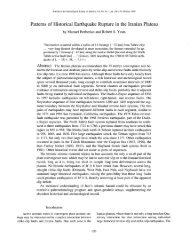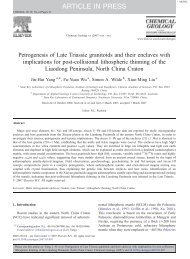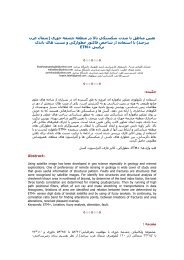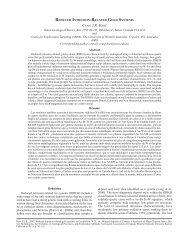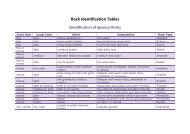Subevent analysis for the Tabas earthquake of September 16, 1978 ...
Subevent analysis for the Tabas earthquake of September 16, 1978 ...
Subevent analysis for the Tabas earthquake of September 16, 1978 ...
Create successful ePaper yourself
Turn your PDF publications into a flip-book with our unique Google optimized e-Paper software.
18 I. Sarkar et al. / Physics <strong>of</strong> <strong>the</strong> Earth and Planetary Interiors xxx (2005) xxx–xxx<br />
Table 2<br />
Estimated source parameters <strong>of</strong> <strong>the</strong> different subevents<br />
Sub-event Station f c (Hz) M 0 (N m) M w r (km) E (erg) σ (bar) D (m) L (km)<br />
S1 <strong>Tabas</strong> 0.19 0.01 × 10 20 5.97 3.9 2.4 × 10 21 7.4<br />
Boshroyeh 0.01 × 10 20 5.97 2.4 × 10 21 7.4<br />
S2 Boshroyeh 0.10 0.70 × 10 20 7.20 7.5 1.7 × 10 24 75.5<br />
Deyhook 0.90 × 10 20 7.27 2.8 × 10 24 95.3 25.5 18.80<br />
<strong>Tabas</strong> 1.02 × 10 20 7.30 3.6 × 10 24 108.0<br />
S3 Boshroyeh 0.10 0.12 × 10 20 6.69 7.5 5.0 × 10 22 12.7<br />
Deyhook 0.30 × 10 20 6.95 3.1 × 10 23 31.8 8.49 18.80<br />
<strong>Tabas</strong> 0.20 × 10 20 6.83 1.4 × 10 23 21.1<br />
S4 Deyhook 0.14 0.04 × 10 20 6.37 5.3 1.5 × 10 22 11.7 2.27 13.29<br />
S5/S6 Deyhook 0.14 0.04 × 10 20 6.37 5.3 1.5 × 10 22 11.7 2.27 13.29<br />
S6/S5 <strong>Tabas</strong> 0.14 0.04 × 10 20 6.37 5.3 1.5 × 10 22 11.7<br />
to <strong>the</strong> corresponding observed SH-wave displacement<br />
spectra (|U(f)|) in <strong>the</strong> high fidelity frequency band<br />
viz. (0.1–0.2) Hz to (4.0–6.0) Hz (see Fig. 6). In this<br />
ma<strong>the</strong>matical expression (5), f denotes <strong>the</strong> frequency<br />
expressed in Hz, t <strong>the</strong> travel time, GS(R) geometrical<br />
spreading, and R <strong>the</strong> source receiver distance.<br />
GS(R)=R −1 <strong>for</strong> R ≤ R y and GS(R)=(RR y ) −0.5 <strong>for</strong><br />
R > R y . R y may be taken as twice <strong>the</strong> thickness <strong>of</strong><br />
crust (Herrmann and Kijko, 1983). We have taken R y<br />
as 90 km (Berbarian, 1982). The term exp(−πft/Q S )<br />
accounts <strong>for</strong> <strong>the</strong> attenuation at high frequencies and<br />
describes inelastic attenuation <strong>of</strong> waves (e.g. Dainty,<br />
1981; Fletcher, 1995).<br />
The best-fit Brune model spectra (Fig. 6) can now<br />
be extrapolated to <strong>the</strong> long periods to provide <strong>the</strong> most<br />
appropriate estimates <strong>for</strong> <strong>the</strong> corner frequency (f c ) and<br />
<strong>the</strong> zero spectral level (Ω 0 ) <strong>for</strong> each case (Fig. 6).<br />
The seismic moment (M 0 ) is <strong>the</strong>n given by M 0 = FΩ 0<br />
where F =4πρβ 3 /F SH R θφ (Hanks and Thatcher, 1972),<br />
ρ is <strong>the</strong> density, β shear wave velocity, F SH is <strong>the</strong><br />
free surface effect (=2) and R θφ is <strong>the</strong> radiation pattern<br />
calculated from <strong>the</strong> estimated fault plane solution.<br />
The moment magnitude (M w ) can be estimated from<br />
M w = (2/3)log M 0 − 10.7, where M 0 is expressed in<br />
dyne cm (Lay and Wallace, 1995). The radius <strong>of</strong> equivalent<br />
circular dislocation surface (r) isr = 2.34β/2πf c ,<br />
<strong>the</strong> energy radiated in <strong>the</strong> <strong>for</strong>m <strong>of</strong> shear waves (E) is<br />
E = (128π 3 ρβR 2 Ω0 2 f c 3 )/15 and <strong>the</strong> apparent stress<br />
drop (σ) isσ = µE/M 0 , where µ is rigidity modulus<br />
(Hanks and Thatcher, 1972). We use <strong>the</strong>se <strong>for</strong>mulae<br />
to estimate <strong>the</strong> source parameters <strong>of</strong> <strong>the</strong> different<br />
sub-events (S1, S2, S3, S4, S5 and S6) (see Table 2).<br />
We have assumed an average shear wave velocity<br />
(β) = 2.0 km/s, rigidity modulus (µ) = 2.0 × 10 11<br />
dynes/cm 2 and average density (ρ) = 1.5 g/cm 3 <strong>for</strong> our<br />
calculations. Although <strong>the</strong>re is no detailed seismic<br />
velocity structure available <strong>for</strong> <strong>the</strong> <strong>Tabas</strong> region,<br />
Berbarian (1982) and Niazi and Shoja-Taheri (1985)<br />
inverted regional and local data to suggest a shear<br />
wave velocity <strong>of</strong> about 2 km/s in <strong>the</strong> shallow (



